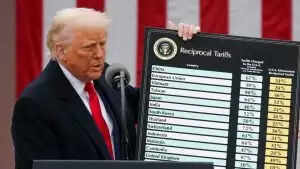Trump's Tariff Strategy: A Bold Move or Economic Gamble?
Trump's Protectionist Measures Unveiled

The American poet T.S. Eliot once remarked that 'April is the cruellest month,' a sentiment that resonates with the recent actions of President Donald Trump. After weeks of threats and indecision, Trump has revealed his protectionist agenda aimed at revitalizing the American economy, as he proclaimed during his presentation on April 2 in the White House Rose Garden. His strategy involves implementing reciprocal tariffs to rectify what he perceives as years of unfair trade practices that have allowed other nations to exploit the U.S.
While Trump's assertion that other countries have taken advantage of the U.S. holds some truth, his approach could significantly alter the landscape of international trade. Economists largely criticize his policies, yet Trump boldly declared April 2 as the U.S.'s 'Liberation Day.' His ultimate goal appears to be compelling trade partners to either meet U.S. demands or shift their production to American soil.
Unlike India's past economic measures, which were often politically motivated, Trump's America-first strategy may seem harsh but is expected to create jobs and opportunities domestically. His stance on trade has remained consistent for four decades.
A baseline tariff of 10% on exports to the U.S. will be applied universally, with additional tariffs imposed based on each country's trade surplus. For instance, Chinese goods will face a 34% tariff, while those from the European Union will incur a 20% charge. Japan's products will be taxed at 24%, and Indian imports will see a 26% tariff. Trump indicated that these new tariffs could be added to existing ones.
This initiative reflects Trump's assertive governance style, showcasing America's economic power. However, the new trade regime he proposes raises several concerns.
Firstly, the tariff rates appear to be arbitrarily determined, influenced not only by existing tariffs in targeted nations but also by contentious factors such as alleged currency manipulation and various taxes. The decision to instigate a trade upheaval globally is a serious matter, and Trump's unilateral approach is unprecedented.
Secondly, the uncertainty stemming from these aggressive tactics creates a precarious environment. Trump aims to control U.S. tariffs based on how compliant trade partners are with American demands. This one-sided negotiation strategy does not foster a conducive business climate, as investors require stability and predictability before committing their resources.
Lastly, Trump's declaration of 'Liberation Day' could potentially plunge the global economy into a recession, a concern echoed by numerous respected American economists. Contrary to Trump's claims, it is likely that American consumers will bear the brunt of these tariffs through increased prices. Current forecasts indicate rising inflation, while growth predictions and the value of the dollar are on a downward trend.
Moreover, Trump's economic assertiveness may provoke retaliatory actions from other nations. The European Union has signaled its intention to respond, and China has already begun retaliating. The nature of this retaliation will depend on how affected countries navigate their trade relations. It is evident that Trump is steering the world towards unprecedented economic transformations, which could lead to a more fragmented global economy, compelling nations like India to become more self-reliant.
